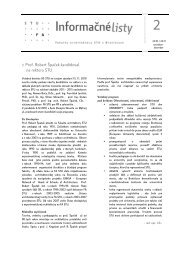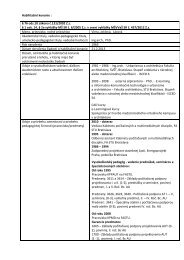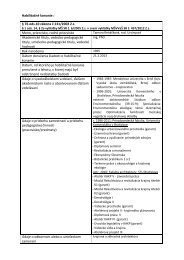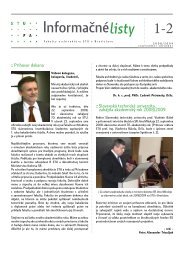ALFA 3-4/2005 - Fakulta architektúry STU
ALFA 3-4/2005 - Fakulta architektúry STU
ALFA 3-4/2005 - Fakulta architektúry STU
Create successful ePaper yourself
Turn your PDF publications into a flip-book with our unique Google optimized e-Paper software.
Ročník 9<br />
3-4 / <strong>2005</strong> ARCHITEKTONICKÉ LISTY FA <strong>STU</strong><br />
- The institutions, organizations and supporting programmes<br />
concerned with hospice care:<br />
In the year 2002 and 2003 The Ministry of Health Care provided<br />
financial support from lotteries for reconstruction of about<br />
30 objects where hospices and departments for palliative care<br />
would be established.<br />
The Association of Hospice Care in Banská Bystrica works in<br />
the whole Slovak Republic.<br />
Very important institutions for the expansion of a hospice<br />
movement are:<br />
- See charity in Banská Bystrica, Košice<br />
- Slovak Catholic Charity<br />
- The National Oncology Institute – Departement of<br />
Palliative care in Bratislava<br />
- the association -The League Against Cancer<br />
- The Foundation Hospice Martin in Martin and many<br />
others.<br />
HOSPIC AS A TYPOLOGICAL CLASS<br />
The basic characterization of the hospice:<br />
The status of hospice in the system of health care:<br />
Hospice is for patients whose illness no longer responds to<br />
aggressive, cure-oriented treatments. Hospice provides pain and<br />
symptom relief, as well as emotional and spiritual support for<br />
patients and their families.<br />
Hospice is serious medicine. Most hospices are certified, that<br />
means that they employ experienced medical and nursing<br />
personnel with skills in symptom control. Hospices offer state-ofthe-art<br />
palliative care, using advanced technologies to prevent or<br />
alleviate distressing symptoms.<br />
The basic functions of the hospice:<br />
Physician services<br />
Nursing services<br />
Home health care<br />
Spiritual, dietary, and other counseling<br />
Continuous care during crisis periods<br />
Bereavement services.<br />
The categories of hospices:<br />
according to the function:<br />
pure – only for terminal-ill patients:<br />
Hospic provides pain and symptom relief, emotional and<br />
spiritual support for patients and their families.<br />
- 50 -<br />
- combined – with extended activities – for example:<br />
ADOS, stationary for daily-coming patients with various<br />
services (physiotherapeutics, psychotherapeutics,<br />
rehabilitation), educational centre and shops.<br />
As a family-centered concept of care, hospice focuses<br />
as much on the grieving family as on the dying patient.<br />
Most hospice make their grief services available to<br />
the community at large, serving schools, churches and<br />
the workplace.<br />
. according to the sort of patients:<br />
- hospice for adults<br />
Hospice patients typically are in their last six months<br />
of life. Approximately 2/3 of hospice patients are over<br />
the age of 65.<br />
- hospice for children<br />
Although the majority of hospice patients are older, hospices serve<br />
patients of all ages. Many hospices offer clinical staff with<br />
expertise in pediatric hospice care.<br />
The first hospice for children – Helen House in Oxford was<br />
founded in 1982. The main aim of the hospice for children is to<br />
upkeep the quality of life of a child and to provide the support to<br />
all family members. Hospice for children offers several types of<br />
care: resting (reposing) care - for several hours, days or for one

















